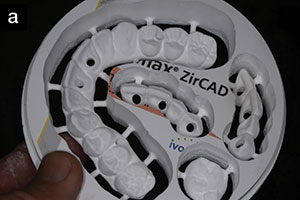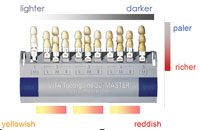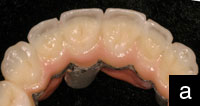Cosmetic dentistry has become more prevalent in our culture due to media coverage on television and in print. Patients are asking more and more about the various possibilities of changing their dental appearance. Dentists are increasingly sending diagnostic study models to the laboratory and requesting mock-ups in order to show patients these possibilities (Figures 1 and 2). After all the excitement of case acceptance settles, the dentist now has the task of converting the mock-up (wax-up) into reality.
According to the CRA Foundation Newsletter,1 67.6% of respondents to a CRA Product Use Survey reported they cut minimal veneer preparations, mostly in enamel. Of the respondents, 27.9% reported that their preparations cut into dentin in cases of highly restored teeth, dark, discolored teeth, deep caries, or if significant changes in occlusion were needed. In order to mask significant discoloration or misaligned teeth without excessive overcontouring, the placement of laminate veneers does require some preparation of the teeth.
 |
 |
| Figure 1. Facial view of the diagnostic study model shows misalignment of the anterior teeth. |
Figure 2. Occlusal view of the diagnostic study model shows misalignment of the anterior teeth. |
There are advocates of “no tooth preparations.” The problem with excluding tooth preparations is the potential for overcontouring and the inability to block cement or underlying tooth color. On the other hand, CRA1 points out that successful long-term results are proportional to the amount of enamel remaining after preparations. Peumans2 concluded in a recent 10-year study that one of the major reasons for laminate veneer failure between the 5-year and 10-year mark was the lack of enamel if teeth were heavily prepared. His group found that the failure rate increased as the remaining enamel for bonding decreased.
To conserve enamel in laminate veneer preparations, Gürel3 states that the amount of tooth reduction should never be made according to the existing tooth surface but rather to the final volume of the restoration. By adding a minimum thickness to the existing teeth, which would represent the final outcome, the clinician could cut back the required amount of laminate veneer thickness, yielding a more conservative tooth preparation. For example, if we add 0.5 mm of facial thickness to the labial aspect of a tooth and regard this contour as the final restoration, the depth of the preparation can start from the new surface. Using burs of known depth, the required reduction is controlled and lessens the removal of enamel.
The method by which the clinician adds volume to the labial tooth surface before commencing the preparation is referred to as the additive contour technique. This procedure adds a minimal thickness of wax or composite to the labial surface of the anterior teeth on the diagnostic casts. The mock-up is then transferred to the patient using a vacuum stent. The increase in thickness represents the volume of the finished restorations. Adding this small amount of thickness to the teeth minimizes the amount of enamel reduction. With the mock-up in place, the patient can approve a simulated final restoration before the clinician starts the preparations. This step acts as a guide for the clinician and accurately dictates the end result. Knowing the required thickness of the laminate veneer, the clinician can then prep back from the finished labial surface. The requisite amount of reduction is made with burs of known depth (round burs). The additive contour technique provides a predictable outcome for both the clinician and the patient.
In cases where the teeth are not properly aligned, the technique involves altering portions of the teeth on the diagnostic cast. Composite or wax is then applied to the teeth to provide the proper contour. Before transfer of the mock-up from the diagnostic model to the patient occurs, the same amount of alteration must be made on the patient’s teeth in order for the vacuum stent to seat properly. If the laboratory has made significant alterations to the diagnostic cast prior to the initiation of the wax-up, then it can be difficult to duplicate those changes on the patient’s dentition before seating the vacuum stent.
One solution is for the laboratory to create a second diagnostic model that shows the alterations without the mock-up. The clinician then duplicates the alterations on the patient’s teeth freehand. This “eyeballing” technique may not accurately reproduce the changes on the model and may present difficulties during the mock-up transfer.
To help alleviate this challenge for the clinician, a device has been developed called a Helvey-Thompson Open Window stent (H-TOW). It provides the clinician an accurate means of removing the same amount of tooth structure that the laboratory technician removed from the diagnostic cast prior to the initiation of the mock-up.
H-TOW TECHNIQUE
 |
 |
|
Figure 3. Tru-Tain 0.020 used to create the H-TOW stent is fabricated on diagnostic model. |
Figure 4. Facial view of the H-TOW cut 3 to 4 mm above gingival margin. |
 |
 |
|
Figure 5. Standard archform orthodontic archwire placed over the incisal edges of the anterior teeth and buccal cusps of the posterior teeth. The complexity of misaligned anterior teeth is revealed. |
Figure 6. Areas outside the desired archform are trimmed back using a 12-b surgical blade. |
 |
 |
|
Figure 7. Facial view of the “windows” created on the H-TOW stent after removing tooth structure on the diagnostic cast. |
Figure 8. The lateral view of the H-TOW stent that shows other areas that will need to be reduced prior to the mock-up exercise. |
 |
 |
|
Figure 9. The orthodontic archwire is replaced on the incisal edges to confirm sufficient tooth structure has been removed to the desired archform. |
Figure 10. H-TOW appliance removed from the diagnostic model. Note the open windows that depict areas that were modified. |
(1) Key the diagnostic model by forming 3 V-shaped grooves on the anterior and posterior aspects on the base of the model.4 The grooves facilitate reseating the model on the articulator mounting. Apply a separating medium to the base of the diagnostic model. Mount the diagnostic casts on a semiadjustable articulator (Panadent). This mounting method will allow the diagnostic cast to be removed from the articulator and replaced in the same position.
(2) Remove the indicated diagnostic cast from the articulator and fabricate a vacuum stent using 0.020 copolyester thermoforming material (Tru-Tain). It is critical that the vacuum stent material have sufficient stiffness to limit the amount of distortion when it is placed intraorally (Figure 3). Cut out the vacuum stent using a No. 25 surgical blade (Myco Medical) 3 to 4 mm above the gingival margin (Figure 4).
(3) With the vacuum stent seated on the diagnostic cast, a standard archform orthodontic archwire is placed over the incisal edges of the anterior teeth and the buccal cusps of the posterior teeth. Viewing from the occlusal, one can determine areas of tooth structure that are either inside or outside the desired archform and need to be reduced prior to initiating the mock-up (Figure 5). The indicated areas of tooth structure are removed using a 12-b surgical blade (Myco Medical). The surgical blade will first cut through the vacuum stent material and then reduce the tooth structure on the diagnostic cast (Figures 6 to 8). The orthodontic archwire is then replaced on the incisal edges to confirm that sufficient tooth structure has been removed to the desired archform (Figure 9).
(4) After the required tooth structure is altered on the diagnostic cast, the H-TOW appliance is removed from the model. The appliance will now have perforations or windows where the surgical blade has cut through (Figure 10). The H-TOW appliance is placed aside.
(5) The altered diagnostic cast is returned to the articulator and secured to the mounting. Using wax or composite resin, the mock-up is now completed to the desired tooth form and alignment (Figure 11).
(6) After completion of the mock-up, the diagnostic cast is removed from the articulator. If wax was used for the mock-up, then the diagnostic cast must be duplicated using a duplicating material and poured in stone before fabricating a vacuum stent. If composite resin was used, then the duplication step can be omitted.
(7) A second vacuum stent (mock-up stent) is made from the completed diagnostic mock-up. A 0.020 polypropylene ther-moforming material (Tru-Tain) is used to prevent composite resin from adhering to the vacuum stent (Figure 12).
(8) The diagnostic mock-up stent is removed from the cast by cutting along the gingival margin of the modified teeth using a 12-b surgical blade (Figure 13). This will allow the clinician to remove excess composite material that extrudes during placement of the stent. Around all other areas of the cast the stent is cut 2 mm above the gingival margin (Figure 14).
 |
 |
|
Figure 11. Composite resin is used to fabricate the mock-up on the altered diagnostic model. |
Figure 12. A second vacuum stent using 0.020 coping material is fabricated on the completed diagnostic mock-up. |
 |
 |
|
Figure 13. Using a 12-b surgical blade the diagnostic mock-up stent is cut along the gingival margin in the areas of the involved teeth. |
Figure 14. Diagnostic mock-up stent removed from the model shows scalloped cut around gingival margins of the anterior teeth. |
 |
 |
|
Figure 15. Facial view of the H-TOW appliance in position. Note the tooth structure outside the open window. |
Figure 16. A 014 or 016 tapered diamond bur is used to reduce tooth structure outside the open window. |
 |
 |
|
Figure 17. Tooth structure is reduced, mimicking the amount that was removed on the diagnostic model prior to the mock-up. |
Figure 18. A thin bead of incisal composite resin is placed in the incisal area of the stent to achieve a translucent effect. |
 |
 |
|
Figure 19. The remainder of the stent is filled with the desired shade of composite resin. |
Figure 20. The mock-up transferred from the diagnostic model to the patient. |
(9) At the mock-up placement appointment, the H-TOW appliance is positioned on the teeth (Figure 15). All tooth structure outside the windows of the appliance is removed using a 014 or 016 tapered diamond bur (Figures 16 and 17). The appliance is then removed.
(10) The mock-up stent is tried on the teeth to verify a passive fit. It is then removed. The surfaces of the teeth that will be altered by the mock-up are etched with 37% phosphoric acid for 20 seconds. The etchant is rinsed thoroughly, and the teeth are dried. A 2-step primer/adhesive (OptiBond Solo Plus [Kerr]) is applied and then polymerized with a curing light.
(11) A low-viscosity composite resin (Prodigy [Kerr]) is used as the mock-up material. A thin bead of incisal shade is placed in the incisal area of the stent (Figure 18). Then the remaining area is filled with the desired shade that the patient and clinician selected (Figure 19).
(12) The loaded mock-up stent is slowly positioned on the patient’s teeth. Once the stent is in place, excess composite is removed at the gingival margins. The composite resin is then polymerized with a curing light for 20 seconds per surface.
(13) The mock-up stent is removed. Using 12-fluted flame finishing burs, the mock-up is refined around the margins and interproximal areas. The occlusion is checked in centric and eccentric excursions, and any interferences are removed. Phonetic testing for f and s sounds is then completed. Once the patient approves the contours and length, polishing is completed using Kerr’s Identoflex Ceromer Polishing System (Figure 20).
Before dismissal, instructions are given to the patient. The instructions prepare the patient for what to look for in the next several days. It is important to explain to the patient that the lip will accommodate the increased fullness of the teeth during that time. Any interference in chewing or speech will need to be reported. It is during this time that the patient has the opportunity to accept the shade or choose to modify it. It is sometimes difficult for a patient to select a shade based on a single shade tab. Wearing the mock-up for a few days allows the patient to scrutinize the shade in “real-time” and prevents dissatisfaction after the final restorations are in place.
The mock-up represents the length, contour, and shade of the final restorations and acts as a blueprint for the laboratory technician. Prior to the actual tooth preparations, a detailed impression is made of the mock-up and is sent to the laboratory. All information the laboratory will need regarding contour, incisal length, and position is contained in this impression. The patient is investing a substantial amount of money in his or her smile. It is essential that the clinician satisfy the patient’s expectations. Using a prepreparation mock-up allows the patient the chance to see what he or she is paying for and prevents disappointment with the final result.
References
1. Clinical Research Associates. Upper anterior veneers – state of the art (part 1). CRA Foundation Newsletter. 2006;
30(1):1-3.
2. Peumans M, De Munck J, Fieuws S, et al. A prospective ten-year clinical trial of porcelain veneers. J Adhes Dent. 2004;6:65-76.
3. Gürel G. The Science and Art of Porcelain Laminate Veneers. Chicago, Ill: Quintessence Publishing; 2003: 243.
4. Henderson D, Steffel VL. McCracken’s Removable Partial Prosthodontics. 4th ed. St Louis, Mo: Mosby; 1973: 375.
Dr. Helvey is a Master in the AGD and is an adjunct associate professor at Virginia Commonwealth University School of Dentistry, where he teaches cosmetic dentistry with emphasis on laminate veneers in the AEGD residency program. He is also a laboratory technician, which has aided in the development of his laminate veneer techniques. Dr. Helvey has published peer-reviewed articles in the Journal of Prosthetic Dentistry, Practical Procedures and Aesthetic Dentistry, The Compendium, Contemporary Esthetics and Restorative Practice, Dental Dialogue, and Dentistry Today relevant to clinical and laboratory techniques, and has lectured nationally and internationally. He graduated from Georgetown University School of Dentistry in 1976 and maintains a private practice in Middleburg, Va, emphasizing restorative aesthetic dentistry. He can be reached at phident@cs.com.
Mr. Thompson has been a laboratory technician since 1972. He is certified in both crown and bridge and ceramics and has been the general manager of Oral Arts Laboratory in Mobile, Ala, since 1997. He can be reached at (800) 327-4047.











